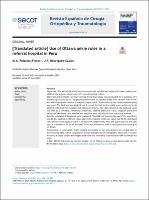Use of Ottawa ankle rules in a referral hospital in Peru
Related Resource(s)
https://www.sciencedirect.com/science/article/pii/S1888441522001096Date
2022-07Author(s)
Palacios-Flores, M.A.
Rodríguez-Cavani, J.F.
Metadata
Show full item recordAlternate title
Uso de las reglas de Ottawa para medio pie y tobillo en un hospital de referencia en Perú
Abstract
Objective: The aim of the study was to evaluate the validity and safety of Ottawa's ankle rules (OAR) in the urgency department of referral hospital in Peru.
Materials and methods: An observational-transversal study was conducted for a duration of 5 months (April–June 2016). Target population were all patients older than 18 years with a foot and ankle injury who came to the urgency department. A convenience non-randomised sampling was used. The OAR test was applied and X-rays of the foot and/or ankle were performed in all patients who met the inclusion and exclusion criteria. The data obtained was analysed using the SPSS 20.0 software. Sensitivity, specificity, positive predictive value, negative predictive value and likelihood ratio positive and negative were calculated from statistical analysis.
Results: A total of 428 patients were evaluated. The OAR test's sensitivity was 97.2%, specificity was 30.3%, positive predictive value was 22.0%, negative predictive value was 98.2%, likelihood ratio positive and negative were 1.39 and 0.09, respectively. With the application of the OAR test, a reduction of 31.2% of the total X-rays was evidenced, which could generate a saving of US $1165.
Conclusions: In conclusion, OAR's validity and safety in our environment are comparable to international data, with a reduction in the unnecessary use of radiographs. Multicentric studies involving a larger sample and longer study time are necessary to protocolize OAR in emergency units. Objetivo: El objetivo del estudio fue evaluar la validez y seguridad de las reglas de tobillo de Ottawa (OAR) en el servicio de urgencias de un hospital de referencia en Perú.
Materiales y métodos: Se realizó un estudio observacional-transversal con una duración de 5 meses (abril-junio de 2016). La población diana fueron todos los pacientes mayores de 18 años con lesión de pie y tobillo que acudieron al servicio de urgencias. Se utilizó un muestreo no aleatorio por conveniencia. Se aplicó el test OAR y se realizaron radiografías de pie y/o tobillo a todos los pacientes que cumplieron los criterios de inclusión y exclusión. Los datos obtenidos se analizaron mediante el software SPSS 20.0. La sensibilidad, la especificidad, el valor predictivo positivo, el valor predictivo negativo y la razón de probabilidad positiva y negativa se calcularon a partir del análisis estadístico.
Resultados: Se evaluaron un total de 428 pacientes. La sensibilidad de la prueba OAR fue 97,2%, la especificidad fue 30,3%, el valor predictivo positivo fue 22,0%, el valor predictivo negativo fue 98,2%, la razón de probabilidad positiva y negativa fue 1,39 y 0,09, respectivamente. Con la aplicación de la prueba OAR se evidenció una reducción del 31,2% del total de radiografías, lo que podría generar un ahorro de US$ 1165.
Conclusiones: En conclusión, la validez y seguridad de OAR en nuestro medio es comparable a los datos internacionales, con una reducción en el uso innecesario de radiografías. Son necesarios estudios multicéntricos con mayor muestra y mayor tiempo de estudio para protocolizar la RAO en las unidades de urgencias.
Collections
- Artículos científicos [890]






